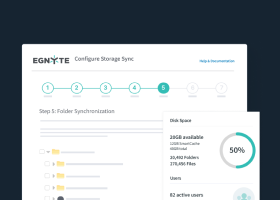Network Attached Storage
Network attached storage is a file-level data storage device or server with a processor and operating system. Also referred to as NAS, it is usually packaged as a pre-built piece of computing equipment, but it can be built from scratch.

Network attached storage supports file sharing by authorized users and heterogeneous clients, as well as other servers over a network. The device is a network node, and the NAS file service uses the Ethernet network to send and receive files.
Network attached storage is one of the three data storage system architectures. The other two options are direct attached storage (DAS) and storage area network (SAN). Common use cases for these three storage architectures are:
- Network attached storage (NAS)—active, scalable, and economical storage for small organizations
- Direct attached storage (DAS)—high-performance storage that is accessible without network access for individuals and small organizations
- Storage area networks (SAN)—high-performance multifaceted systems for organizations that require high efficiency and dependability
NAS vs. DAS
Direct attached storage (DAS), the precursor to network attached storage, is a hard disk drive (HDD) or solid-state drive (SSD) that is connected to a single computer, with each device managed separately. It can also be a single computer’s hard drive or a cable-connected external hard drive. Examples of DAS include:
- CDs
- External hard drives
- Internal hard drives
- USB flash drives
| Direct Attached Storage (DAS) | Network Attached Storage (NAS) |
| Cannot be managed over a network | Can be managed over a network |
| Capacity up to 2 TB | Capacity up to 10 TB |
| Comparatively inexpensive—only costs are those associated with the disk drives and any drive enclosures (requires no additional hardware or software to run and manage) | More expensive—requires hardware and software to run and manage the storage system |
| Easy to install—often comes preinstalled | Moderately difficult to install |
| Difficult to share storage with multiple users | Easy to share storage with multiple users |
| Does not allow files to be shared across different operating systems | Allows files to be shared across different operating systems |
| Does not support collaboration | Supports collaboration |
| IDE/SCSI used for data transmission | TCP/IP, Ethernet used for data transmission |
| Less complex than network attached storage | More complex than DAS |
| Less expensive than network attached storage | More expensive than DAS |
| Limited scalability—restricted by the number of internal drive bays, the capacity of external devices, and the availability of external ports on individual devices | Highly scalable—scale up by adding additional drives or scale-out by using clusters and adding nodes |
| Minimal accessibility | Very accessible with network connectivity |
| No backup | Consistent, automated data backup |
| No data redundancy | Data redundancy available |
| No centralized management | Offers centralized management console |
| Used for backups and recovery | Used for backups and recovery |
| Uses sectors for backups and recovery | Uses files for backups and recovery |
NAS vs. SAN
A storage area network (SAN) is a specialized, independent high-speed network that connects authorized users and servers and provides access to shared pools of storage devices.
Multiple servers can access shared storage with a SAN, as if it were a directly-attached drive. Since SAN works on a separate network, it works similarly to the direct attached storage (DAS).
| Storage Area Network (SAN) | Network Attached Storage (NAS) |
| Block-level data will be stored | Data stored and accessed in the form of files |
| Commonly used in professional and enterprise environments | Commonly used in homes and small to medium-sized businesses |
| Data accessed as if it were a local hard drive | Data accessed as if it were a network-attached drive |
| High-speed—uses Fibre Channel, most commonly available in 16 Gb/s to 32 Gb/s | Variable speed that is dependent on local TCP/IP Ethernet network, which is most commonly 1GbE to 10GbE, but can be impacted by the number of users accessing the storage at the same time |
| Highly scalable—add more storage controllers or expanded storage arrays, allowing SAN admins to scale performance, storage, or both | Variable scalability—lower-end is not highly scalable; high-end can scale to petabytes using clusters or scale-out nodes |
| Higher throughput | Slower throughput |
| Lower latency | Higher latency |
| Low-level file sharing protocols—Fibre Channel, iSCSI, and FCoE | High-level file sharing protocols—SMB/CIFS, NFS, SFTP, and WebDAV |
| More expensive | Less expensive |
| Not a place to archive files immediately | A centralized place to back up or sync files |
| Requires dedicated Fibre Channel connections for clients, servers, and storage, and often a separate, dedicated Ethernet network for file request traffic | Connects to existing Ethernet network |
| Requires more administration | Easier to manage |
| Used for structured workloads, such as databases and data warehouses | Used for unstructured data, such as multimedia files, surveillance video, and medical images |
Business Uses for Network Attached Storage
- Scale-out capacity
Increase the capacity of network attached storage by adding more hard disks, rather than upgrading or replacing existing servers - Fault tolerance
Format network attached storage to support replicated disks, a redundant array of independent disks, or erasure coding to ensure data integrity - Network attached storage
provides a local area network (LAN) with file-based, shared storage in the form of an appliance that is optimized for quick data storage and retrieval (i.e., hot data that is frequently accessed) - Data protection with network attached storage to create and maintain:
- Immutable data snapshots that cannot be edited, overridden, deleted, or changed so they can be used to restore production servers immediately in case of ransomware attacks or other data loss
- Write-once read-many (WORM) volumes that are set to append-only, so that data can only be added to the end of the volume
- Ability to run a variety of applications on network attached storage devices:
- Business applications, such as customer relationship management (CRM), enterprise resource planning (ERP), human capital management (HCM), and supply chain management (SCM)
- Multimedia transcoding and serving
- Productivity tools, such as email, documents, and spreadsheets
- Collaboration and file-sharing applications
- Private/public cloud integration
- Web servers
- Software development
- Network attached storage is used to perform a number of other tasks, including:
- Quickly accessible data storage and sharing
- Active data archives or for data backup and disaster recovery
- Virtual desktop infrastructure hosting
- Media file and torrent streaming
- Repository for images and videos that require frequent access
- Internal printing repository
- Hosting messaging applications
Network Attached Storage Disadvantages
Among the reported disadvantages of network attached storage are:
- Capacity peaks at 10 TB
- Difficult to scale
- Lack of storage service guarantees
- Network issues result in latency
- Performance is limited by network speed, and the network attached storage’s hardware
- Reliance on hard disk drives (HDDs) to serve data
- Repairs are also more difficult to make on network attached storage
- Require more administrator management than DAS.
Although network attached storage can have a storage array, the number of bays is fewer than what would be found in a typical server. Due to this, network attached storage is unable to provide redundancy by replicating the network with various servers and storage arrays. In addition, because network attached storage is physically on-site, it is more susceptible to data loss from natural disasters or device theft.
Network attached storage can also negatively impact LAN traffic as usage of the storage increases. Heavy usage of network attached storage can cause congestion on shared LANs and slow traffic for other users. Due to this, network attached storage should not be used to support applications where users transfer large batches of data, such as multimedia or video files.
The inherent space constraints of network attached storage also create issues. To ensure that all users have access to storage, administrators have to establish and enforce quotas.
These limitations are commonly cited as reasons to consider alternatives to network attached storage for mission-critical operations. However, the more significant weaknesses of network attached storage are related to scalability and performance capabilities:
- Latency as more users need more access
- Costs to expand the network attached storage with more powerful components, such as a larger onboard processors, more memory, and faster and more extensive network connections
- Limitations of the Ethernet, LAN, and protocols, such as Network File System (NFS) and SMB, which underpin the network attached storage
Network Attached Storage Alternatives
A few capabilities to consider when reviewing alternatives to network attached storage alternatives are:
- Backup and recovery
- Where will files be backed up?
- How frequently will files need to be backed up?
- How quickly do files need to be restored in the event of a disaster?
- What would the consequences be if files were lost, damaged, or stolen?
- Budget
- How much is allocated to purchase a storage solution?
- How much is available for ongoing support and maintenance?
- Is there budget for purchasing additional hardware components if the storage needs to be expanded?
- Capacity
- How much data needs to be stored?
- IT Staff and Resources
- Is there a dedicated IT staff person to manage the system?
- Performance
- How many employees will need to share/access or collaborate on files, from where (i.e., remote or in-house,) and how often?
- Reliability
- What is the level of reliance on data, files, and applications?
- What would downtime do?
- Scalability
- How much data will need to be stored over the next several years?
Five Types of Commonly Used Alternatives to Network Attached Storage
- Object storage
Object storage, also known as object-based storage, holds large volumes of unstructured data as distinct units. Each piece of data is designated as an object. Easily scalable, this network attached storage alternative collects objects in a single storehouse rather than storing them in separate files inside other folders.
Object storage combines the pieces of data that make up a file, bundles it with metadata, and adds a unique identifier to facilitate access and retrieval. Everything is placed in a flat address space, called a storage pool.
The metadata is key to the success of object storage, because it enables complex search capabilities as well as analysis of the use and function of data in the storage pool.
Objects can be stored anywhere, but cloud storage is generally used rather than on-premises storage to make them easily accessible from anywhere. Due to object storage’s scale-out capabilities, there are virtually no limits to scalability. In addition, object storage is a cost-effective network attached storage alternative for large data volumes.
- Distributed file system
A distributed file system is a file system with data stored on multiple file servers, called nodes, across multiple locations (i.e., in the same region or across continents). The system is composed of several servers connected via a network, such as Ethernet or the internet.
An alternative to network attached storage, a distributed file system allows users to access or store files from any network or computer as if it was stored on the local client machine.
This model allows users to share information and files on a network while enforcing access controls. Security is enforceable, because the distributed file system servers have full control over the data and grant access control to users based on permissions.
The distributed file system also creates redundancy for data availability. If a single server is down or disabled, the entirety of data is backed up and distributed across several other nodes—unlike network attached storage.
- Cloud file storage
A cloud-based alternative to network attached storage, cloud file storage provides servers and applications access to data through shared file systems. Cloud file storage is provided either through third parties as a managed service or with internal systems that reside off-premises.
This highly compatible storage is ideal for workloads that rely on shared file systems, because it enables simple integration without code changes. Cloud file storage is used to support a broad spectrum of applications and verticals. - Cloud file system
A cloud file system is a hierarchical storage system that provides shared access to file data. Users can create, delete, modify, read, and write files, and organize them logically in directory trees for easier access.
Cloud file systems have an architecture based on common file-level protocols (e.g., Server Message Block or SMB, Common Internet File System or CIFS, and Network File System or NFS. The most common uses of cloud file systems are for unstructured or semi-structured data, such as documents, spreadsheets, presentations, and other file-based data. - Redundant Array of Independent Disks (RAID)
A RAID allows data to be stored across multiple hard drives for redundancy, data protection, and improved performance. Mirror-based, or parity-based, RAID implementations automatically spread write operations across multiple disks to ensure that two or more identical disk copies are always available.
In addition, RAID stripe sets are used to spread read and write operations across multiple disks to optimize IOPS (i.e., input/output operations per second). This maximizes the number of reads and writes to non-contiguous storage locations, which increases performance.
Make Data Safe and Accessible Network Attached Storage or Other Options
All organizations have vast amounts of data that must be collected, stored, and accessed—all while minding requirements for data protection. Network attached storage is one of many options available for that.
In most cases, multiple storage solutions are used to provide optimal service levels—from day-to-day usage, which is commonly supported with network attached storage, to archiving, which is often done with object storage. Whichever solutions are selected, always ensure that effective data protection procedures are in place.
Egnyte has experts ready to answer your questions. For more than a decade, Egnyte has helped more than 16,000 customers with millions of customers worldwide.
Last Updated: 16th May, 2022




